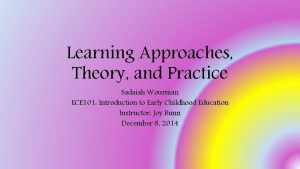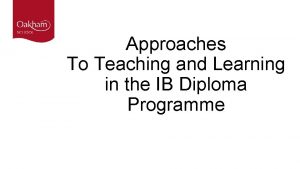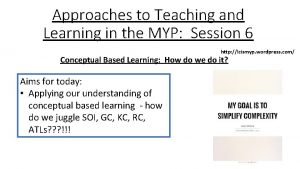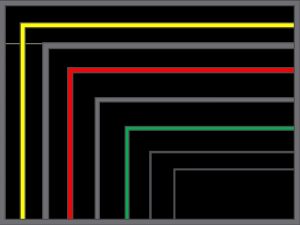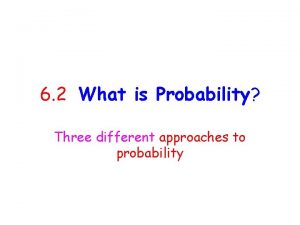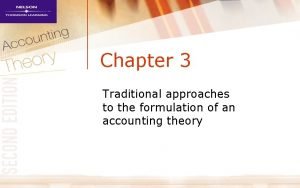Learning Approaches Theory and Practice Sadaiah Wourman ECE







- Slides: 7

Learning Approaches, Theory, and Practice Sadaiah Wourman ECE 101: Introduction to Early Childhood Education Instructor: Joy Bunn December 8, 2014

Theorists/Theories – Most connected to least connected Learning Approaches – Most connected to least connected 1. Skinner: Operant Conditioning Theory 1. Creative Curriculum 2. Kohlberg: Theory of Moral Development 2. Reggio Emilia 3. Erikson: Theory of Psychosocial Development 3. High/Scope 4. Piaget: Theory of Cognitive Development 4. Montessori 5. Gardner: Theory of Multiple Intelligences 5. Direct Instruction 6. Bandura: Social Learning Theory 7. Freud: Psychosexual Theory of Development 8. Vygotsky: Sociocultural Theory of Development

m u l u ic r r u C e iv C t a re • Classr to sup ooms are or p physic ort social, ganized int o e a serves l developm motional, c interest ar as the e o ent. P lay an gnitive, lan as designed found • I d guage a child tions f want , and d o i r r t e o l e c arning be mo te childr re by do d activity e ing. repea n to learn of a hands m t thinki ing what so ore by doi on teacher t n n m work g and expe eone else g. Learnin hat allow th s and to r g a learn imenting to ys it requi isn't just e r firsthand find out h es active • In o about using the w w things orld w their i real mate e live deas, r i a in. l s such a childr colors en lea and t s b l o cks an The d hey no rn abo d e I cann velopment tice relatio ut sizes, sh trying out n ap o ot wai t to be f a child is ships betwe es, and • T v e a e n r ble to his te start y importan things. teachi I was aching app t to m ng. t e and what child th roach has r was ta anked at lear and it u has a ght. I have ned better my #1 choi lways • Sk helpe always bee when I was ce due to d me o doing inner: n a vis Oper u u t a l for th t h l e e arner most. eories ant Cond and I child itionin w on act hen that h know that d g theory w a a i activit vities the c ve done someals with re s my top p h i y w i e l and w that they d is able t thing righ arding a ck do an anting o t get re. With d to lea rn mo the child is warded wi hands th stayin re. g focu each sed

• a i l i m E o i g g e R Re to e ggio E nga mi • ge lia p Th in p ro e roj vide use aim ect bas ful in of th s b s you e ase ng com d on ever is ap d o chi p y m n t ldr sup un the day roa hei en c int port ity t princ life. h is r o wit e h i t wn h o T v i res • e a rou ples he each int pp t s o nd gh of ap i n Th ere ort f th en ex re pro g h i sts uni p r e c ich lor spec ach ow hel s ap. ties h t a i p p / t i o n t t l , r dre g e ion re eac ma stu a lo oa s n c h d n th viro and pon ing ke t exp ents t wh h is rou nm di sib sty hem or ress stay en it anoth gh en scov ility le i b c t i e h a s t ba ery , an s o u n ens ild em vo me r h elfa l i s s u gui sed o in a d and re t ng c elve ved. to t nds r e s ded n th h o L e a • lar at t ati thr igh ch n a cu e ge he on ou pp i t n Th t rri g gro re s. D gh ab an roa i cul s l i d c e s u d a Sk is a h s r p a i um ac ba ly s awi allo hel tha. p tiv lan che ng pic inner noth t w i n w itie ce , co ch g th ill d u chi k for : Ope er ap i s l bet les lor dr. we are ing en e inv ld wh theo rant proa t en , r c o ind plan pain o eng lves en th ies a Con h th ivid ned ting age the at nd ditio at I ual to , d. ha hav I kn nin am , sm nd e d s o on ow th g the able all n r e s o t a o r ew om t de y w com ard eth als hic s w ing wit h w pare hic rig h r as to h k ht. ewa my eep Th rd top th is a ing e c lso a hil d

Skinn Cond er: Opera itionin nt g The ory • B. F. Skninner believed that the best way to understand behavior is to look at all causes of action and its consequences. His approach was called the operant conditioning theory. • Skinner showed us three types of responses or operant that can follow behavior. The main source that I would be using in my class room setting would be positive reinforcement. • When it comes to positive reinforcement that can help a lot in a everyday classroom setting when it comes to dealing with younger children. Babies and toddlers like to be rewarded when they have done something correct. Even preschoolers when they have learned something new and they are applying it in the classroom there is never anything wrong with positive reinforcement. It will help a child. • This theory ranked #1 on my list due to this is something that I have a lot of experience with in my house hold. While I potty trained my youngest daughter this theory was used. We decided to go to the dollar store and get a few fun toys and stickers for her. What we did was placed everything in a small bucket and each time she went to the bathroom and told us that she had to potty we allowed her to get a treat out of what we called the potty box. She really seemed to enjoy the treats and knew that her going to the bathroom was a good thing and that she would be rewarded for it. It was well worth it and by the time the potty bag went low she was fully potty trained.

f o y r o e t h n e T : m g p r o e vel b l h e o D K ral Mo • Kohlberg believed that children move through different stages of moral development and that the process of moral development continues through out a persons lifetime. Kohlberg believed and was able to demonstrate through studies that people progressed in their moral reasoning (i. e. , in their bases for ethical behavior) through a series of stages. He believed that there were six identifiable stages which could be more generally classified into three levels. Kohlberg believed that individuals could only progress through these stages one stage at a time. That is, they could not "jump" stages. • According to Kohlberg, children early in their middle childhood stage of development will typically display "Preconventional" moral reasoning. Children displaying preconventional moral reasoning have internalized basic culturally prescribed rules governing right and wrong behavior. Later on in middle childhood, approximately between ages 10 and 12, children begin to show a dawning appreciation of "ideal reciprocity", which is a method for determining what is "fair" based on an appreciation of equality between relationship partners, and a desire to treat others well. • Children who are in the first stage f Kohlberg's theory of Moral Development see that rues are fixed and they must obey them in so that they do not get punished.

References • Estes, L. S. , & Krogh, S. L. (2012). Pathways to teaching young children: An introduction to early childhood education. San Diego, CA: Bridgepoint Education, Inc • http: //www. simplypsychology. org/operant-conditioning. html • http: //psychology. about. com/od/behavioralpsychology/a/introopcond. htm • Zaur, J. , & Simmons, J. (2014). A tale of five classrooms [Interactivity]. Ashford University, College of Education, San Diego, CA. This interaction is required for completion of the Learning Approaches discussio • Zaur, J. , Irwin, J. , & Phillips, J. (2014). ECE 101 theorist gallery tour [Interactivity]. Ashford University, College of Education, San Diego, CA. This interactive learning object is required for the completion of Discussion 1. Z • http: //education-portal. com/academy/lesson/kohlbergs-stages-of-moraldevelopment. html#lesson • http: //www. sevencounties. org/poc/view_doc. php? type=doc&id=37692&cn=127 2
